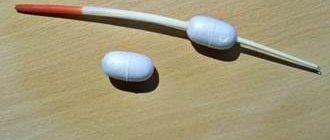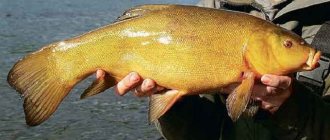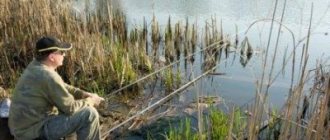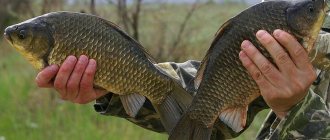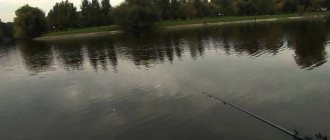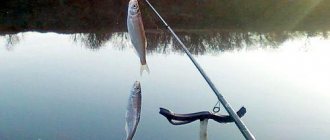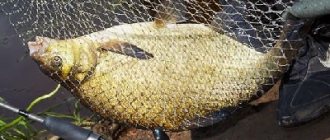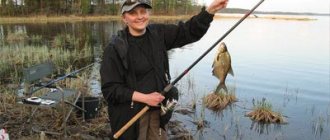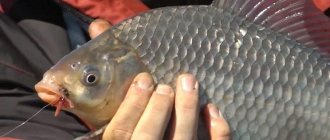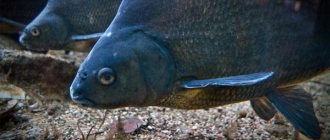Tench is the desired trophy of every fisherman. But its targeted fishing has a number of nuances, non-compliance with which leads to a significant decrease in the number of fish bites, especially those realized. The classic fishing tackle for tench is a regular float rod, but it also requires appropriate equipment and settings. The habits of this fish, in particular its caution, largely determine fishing tactics.
In any case, catching tench with a float rod in the summer is very exciting, and its success will say a lot about the skill of the fisherman.
Catching a tench is not easy - you need to find a parking lot, choose the right fishing time and pick up the keys to the sloth
Habits of tench and promising sites for its sites
Tench prefers reservoirs with weak currents or stagnant water - it is undemanding to the oxygen content in the water, approaching in these indicators the absolutely unpretentious crucian carp. But, unlike the same crucian carp, tench cannot tolerate areas of clean water, always choosing for itself an area of a reservoir with thickets of reeds, water lilies and other aquatic plants. Therefore, when going fishing for this fish, you should immediately be prepared for the fact that you will have to fish in very close proximity to vegetation.
Most often, tench prefer shallow areas of the reservoir, with a depth of 0.4 to 1 meter, the bottom of which is covered with a small layer of silt. In it he looks for his food: crustaceans, mollusks, insect larvae and other small invertebrates. Adults may also feed on algae and detritus. Tench is a fairly sedentary fish, and even in search of food does not go far from its usual places, moving, as a rule, alone.
Tench begins to feed actively when the water warms up to 15 °C, but in the cold season it is inactive. It spawns at a temperature of 18-20 °C around May-early June, and in some areas with cold climates even in August, after which it “gets sick” for about a week, and then increases feeding activity again.
Promising parking and place for catching tench near a wall of cattails or reeds
Where to catch tench
If you are planning to catch tench, keep in mind that the correct choice of location plays an important role. The difficulty in choosing a place to catch tench is due to the fact that tench do not gather in large schools. In the spring, this fish forms pairs, and after spawning, large tench prefer to stay alone. Sometimes you can find areas where small tench bite quite often, apparently they are attracted here by the abundance of food.
Where is the best place to catch tench? As a rule, in rivers, lakes and ponds, this fish chooses muddy backwaters, creeks, and bays with a lot of algae for its habitat. In reservoirs with low-flow water, such places can be very far from the shore, so here you often have to fish from a boat, throwing a float rig under the edge of the algae.
Tench likes to stay above a hard bottom with a small layer of silt. On such soil you can find thickets of horsetail, and it is here that tench most often wander in search of food. Sometimes you can see how the stems of the horsetail sway as the fish moves. So it’s better to catch tench in such places.
Where else it is good to catch tench is in creeks and backwaters that are attractive to tench, which are hidden under water during high water and washed by a strong stream, and then, when the water subsides, they again turn into stagnant areas, fresh organic matter gradually begins to accumulate in them, which the tench finds for itself: nymphs, various kinds of worms, small crustaceans and other organisms. Tench almost always feed on animal food, with the exception of young shoots of algae in early summer. Since tench likes to poke around in the mud, it can be detected by the bubbles appearing on the surface of the water.
Rigging a float rod for a tench - how to assemble a catchy tackle
To catch tench, you usually take a rod 4 to 6 meters long, quite light, to ensure casting into “windows” among the vegetation. The rod should have a rigid action so that it is possible to quickly remove the hooked fish from the thickets, but a rather soft sensitive tip to soften the hook.
The thickness of the fishing line is taken based on the size of the tench individuals living in the reservoir. Typically, the rod is equipped with a main monofilament line with a diameter of 0.2 to 0.3 mm, which is enough to catch even large specimens weighing up to 2-3 kg. Leash with a diameter of 0.12-0.18 mm. A much bigger problem is usually getting caught in vegetation when fishing for hooked fish that tends to go into the thickets.
The float must be attached to the fishing line at several points, preferably three, to ensure sufficient sensitivity - the line is caught from the bottom, while the loading pellet lies in the silt. Usually the float is taken small, up to 3-4 grams of carrying capacity. It is advisable that the part of the float that is in the water does not have bright stripes or cambrics, which can alert the fish.
Equipment for catching tench with a float rod - two options for different types of fishing rods
To ensure that the load does not get buried in the silt, it is usually divided into two or three parts of different weights, the smallest of which should be located closer to the hook. This technique also increases the sensitivity of the tackle, providing the possibility of timely hooking.
The hook is selected based on the size of the tench in a particular body of water. Usually the number 4-7 is taken according to the old Soviet classification. If the tench is caught with a worm - the most common bait - the shank should be long, and the hook itself should have notches that prevent the bait from slipping.
The hook must be sharp - this can be easily checked by running the tip along the nail plate. It should leave a white mark behind it even without pressure. Otherwise, it is better to replace the hook with a new one.
The appropriateness of the leash is disputed by many anglers. Carried away by the search for food in the silt, the tench does not pay attention even to a fairly thick fishing line, and the tackle without a leash becomes more durable, which allows you to avoid breaks when snagged on vegetation.
As a rule, reels are not installed on rods for tench fishing, because the main problem when fishing for tench is avoiding getting caught in the thickets. In this case, fishing is often forced, and releasing the line is not required.
What is the best way to catch tench?
At the beginning of summer, tench are not yet too picky about baits and tench can be caught using live food. It sticks to algae where insects emerge. It is better to catch tench using caddisfly, stonefly, dragonfly, and mosquito larvae as bait. You can also successfully catch tench with amphipods, small leeches, etc. At this time, the fisherman should very carefully observe the processes occurring in the reservoir and, focusing on natural baits that are easily accessible to the fish, combine them with plant baits. In general, as when catching crucian carp, a fisherman on a pond should always have an assortment of baits: about three baits of animal and plant origin.
Since the end of June, the tench bite is no longer so active. And the question of what is the best way to catch tench is especially acute, because tench fishing becomes random. However, seasonal experimentation also yields results here. Much, of course, depends on the temperature of the water and its oxygen saturation. On rivers the picture is one, on low-flowing reservoirs it is different.
It often happened that when I found myself in river backwaters where there was a lot of tench, no matter how much I cast on the worm, everything would bite on it, but not the tench. The fishing trips were one-day, so it was not possible to use long-term bait. I tried catching tench with maggots and bloodworms - the result was the same. What is the best way to catch tench in such cases?
Small rudd, perch, and roach pecked at the worm, and apparently they did not allow the tench to peck. And in such cases, when the fish are capricious, it is better to catch tench using steamed pearl barley.
Once I managed to catch a dozen measuring lines with this bait on one small dam in the Tula region. The pearl barley was placed one or two grains at a time on a corresponding hook with a short shank. I released the float so that the nozzle was located 3–5 cm from the ground. Lin pecked at her without hesitation. And the small roach, which was in abundance here, was not at all annoying.
As for catching tench with a worm, many use a purchased red worm, but tench are very sensitive to foreign odors that an artificially bred worm may have. It’s better, if you’re trying to catch tench with a worm, to take, say, not industrially harvested dendrobene (since it’s not clear how it was harvested and whether it has a foreign smell from an unwashed tool), but dig up the most common earthworms right there on the shore, on which it is a pleasure to catch tench.
On rivers, dams and small lakes it is better to catch tench using a caddis fly as bait.
For example, one day at the beginning of summer, my friend and I were fishing on the Nerl, where caddis houses can be found in horsetail. There were no bites for bloodworms, maggots, worms, pearl barley or other baits. With some effort, I managed to collect a caddisfly. Only then, in the pools under the edges of the algae, the first, then the second tench pecked, and other fish began to confidently take with them.
On many reservoirs, in order to cut off small things, it is better to catch tench with bulky baits, such as pickled corn, and where there are very large tench, even a crawler. I remember how in my youth on the Upa River I managed to catch a three-kilogram tench on a crawl.
Nozzles and baits when catching tench on a float
The most popular bait for tench is a worm. Dung, rain, and large crawls are also suitable when catching trophy individuals is expected. In addition, fishermen use the following baits and attachments:
- leeches;
- dragonfly larvae;
- shellfish meat;
- caddisflies;
- maggot;
- bread or dough made from wheat flour;
- pearl barley;
- processed cheese dough with added cottage cheese.
Tench can be caught well with a worm
Most often, it is animal bait that is used, but the question of the demand for bait should be approached based on the demands of the tench in each specific reservoir. As a rule, the normal worm wins most of the time.
The flavors of herbal attachments deserve special attention. It is best to use natural flavors - for example, honey, without resorting to outright “chemistry”. In order not to waste time searching for the best bait on some body of water, it is better to ask local fishermen about this.
The effectiveness and choice of bait largely depends on the preferences of the tench in a particular body of water. Boiled cereals are most often used - wheat, corn, pearl barley. Sometimes ready-made industrial baits also perform well, but there is no single recipe that always and everywhere shows high efficiency.
Tactics for catching tench with a float rod
The success of tench fishing is largely determined by fishing tactics. If you do not follow the basic requirements for caution and choice of place, the chances of catching this fish drop significantly.
Choosing a promising location
When fishing for tench, you should be especially careful when choosing a promising location. This largely determines the effectiveness of fishing. It is worth paying attention to the following nuances:
- The best places for fishing on lakes and ponds are the borders of thickets with clear water, vegetation with “windows” at a distance of 4-10 meters from the shore, or, in extreme cases, in close proximity to underwater snags;
- On rivers, places with slow currents, floods with reeds, reaches and quiet backwaters are promising;
- The bottom should be muddy, the tench should not stand on areas with a rocky or hard clay surface;
- Noisy and crowded places should be avoided; cautious tench simply leaves them.
There are tench companion plants: horsetail, cattail, reed, egg capsule, urut, pondweed and sedge. Adults of this fish feed on many of them. But the tench avoids thickets of arrowhead, elodea and hornwort. The fish companions of tench are often gold and silver crucian carp or carp, and roach.
Fishing time and weather
Tench does not like bright light; the best time to catch it is early morning or evening twilight. At this time the fish are most active. Bites in the middle of a sunny day are often random.
Ideal linear weather is light drizzle or thick fog. Under such conditions, tench can peck throughout the day. It is even better if such weather persists for a long time, so that there are no sudden changes in atmospheric pressure.
Tench is caught only in the warm season in late spring from May until the end of summer. With the onset of cold weather, it stops feeding and there is no hope of catching it.
Lure
The bait should be sent to the fishing site without unnecessary noise. It should not be plentiful, just to irritate the fish and create an appetite. The activity of tench is often indicated by stripes of small air bubbles, which the fish raise to the surface, rummaging in the mud. After throwing bait, as a rule, you need to wait from 0.5 to 1 hour until the fish calms down and becomes interested in the bait.
Biting and hooking tench, fishing
Tench is very careful; its bite is often very lazy, which creates additional difficulties in its implementation. You need to wait some time for the fish to swallow the bait or bait and only then hook it.
If several worms are attached to the hook at once, they have long “tails”, it is necessary to pause longer before hooking, since the fish does not immediately swallow them. When fishing is done with pearl barley or dough, the pause may be shorter.
Hooked fish exhibit strong resistance when fished out. To prevent it from going into the thickets and getting caught, it is better to bring it ashore in a somewhat forced mode.
Catching crucian carp and tench with a float rod - fishing video:
Fishing technique and tactics
Regardless of the season, catching tench in autumn, spring and summer can only be done in an ambush way by intensively feeding a promising point. If the angler plans to hunt for tench throughout the entire period of open water, then the best option is to install bait, which is recommended to be changed every two days. Careful movements on the shore and in the boat, as well as camouflage of the fisherman, increase the likelihood of successful fishing. Fish move away from overly fussy anglers even with an attractive bait, and it is almost impossible to catch tench with a fishing rod at short distances with careless, noisy behavior.
Bite
A feature of tench biting is a long and monotonous bite, during which the fish savors the bait for a long time, which is visually observed as a leisurely swaying of the float almost in one place. Such savoring can last for 15 or even 20 minutes, ultimately ending with the fish quickly retreating to the nearest thickets and, accordingly, pulling all the equipment there.
Important! Any movement of the float to the side is a signal of cutting, which is carried out in the opposite direction to the movement of the float.
Otherwise, the fish, having gone into dense thicket, will force the equipment to break. Regardless of the type of bait, line bites proceed in the same pattern of the events described above.
Fishing
A powerful and stubborn tench is distinguished by a complex process of retrieving. Difficulties in the final stage of catching a trophy are also added by the cramped fishing conditions, which is facilitated by the abundant thicket around the fishing points. By constant tension of the cord, the fish is not allowed to go into the vegetation and, gradually tiring, they try to pull it to the shore or boat and bring it into the landing net. The strength of the fish’s resistance can be judged by comparing the capture of a three-kilogram carp with a half-kilogram tench, which is felt absolutely identical to the angler in terms of the strength of the struggle.
Tricks and secrets
Tench is very careful, and therefore the success of fishing largely depends on the behavior of the fisherman, his patience and knowledge of the habits of this fish. The following secrets and subtleties of fishing will help make fishing more effective:
- With a sedentary lifestyle tench quickly explores all the surroundings of his camp and even a small change in them can alert the fish. Therefore, cutting out vegetation and preparing windows for fishing is justified only in the long term, when it is possible to wait a few days for the fish to get used to the changes that have occurred.
- Under no circumstances should you talk loudly while fishing for tench - even in a low voice. The fisherman's clothing should be camouflage or dark in color; it is better to sit on the shore rather than stand without making unnecessary movements.
- When fishing from a boat you need to approach the fishing spot as carefully as possiblewithout making splashes with the oars. Fussing and fidgeting in the boat is also undesirable. It is best to stop a few meters from the intended casting point. Fishing right next to the side of the boat, as a rule, does not give any results.
- After catching one fish, the bite on the spot subsides for a while - the tench feeds alone, and the noise from the fishing scares the fish away. Therefore, if possible, it is better to feed several places at the same time so as not to interrupt the fishing.
- One of the best baits is turf, into which a handful of worms are poured . Once in the water, they climb out, attracting fish.
- Some fishermen successfully use the following fishing tactics: several float rods are cast in promising places , after which they are secured so that the fish does not drag them into the water. The fisherman stands at a distance, watching the floats. The tench is spotted on its own, after which the main task becomes its removal from the thickets.
Catching tench in June with a float rod, choosing a place, bait and bait - video from recognized experts the Shcherbakov brothers:
Tench has gained fame as a very neat and careful fish, but its fishing becomes more interesting and exciting. And if you follow certain rules, fishing for it will definitely be crowned with success.
Catching tench in the wilderness
Like bream, tench swim on top on warm nights. Only, if night fishing for bream is practiced almost everywhere, then similar line night fishing is completely unknown. But it is precisely in the hot season of mid-summer, which is recognized as “the wilderness”, that in some reservoirs it is possible to catch tench on top and at mid-water in windows among egg capsules and hornworts. Many slugs, snails, mosquito larvae, water beetles, crustaceans, and dragonflies live on plants in the water at this time. Even bottom-dwelling larvae of the mosquito mosquito, known as bloodworms, can float to the surface and end up near the surface. Most dragonflies and caddis flies crawling along the bottom in their house, at the stage of turning into a flying moth, can also become an excellent bait. If you are not too lazy and, by sailing a boat into the grass, collect these various living creatures, then fishing in the upper layers of water, during the notorious “wilderness” period, may well take place.
For such fishing you will need a light rod about 6-7m long with a live reel. If you fish from a boat, then a rod 4.5-5m long will be enough. No bait is required, since fishing is active and involves catching all the convenient gaps and windows in the grass. And you should still start with bottom and bottom fishing, and then move on to the upper layers of water. As a rule, it is better to fish from the bottom in the early morning, moving on to running fishing in the grass by noon, when it is more promising to fish from the top or in mid-water. Fishing without a float, using a small light-colored jig, can be more sporty and exciting. To do this, you need to drop about one and a half meters of fishing line from the tip of the rod, and lower the jig with the attachment vertically, as in winter fishing, making light oscillatory movements. For such fishing, it is better to equip the tip of the rod with a side nod. Float fishing is traditional and requires only thin equipment and a light float. Although this article talks about fishing for tench, in this case, any fish that previously ignored any baits and methods of fishing during the hot wilderness can catch larvae, snails, and crustaceans.
